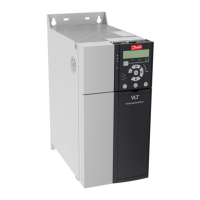8 Test Procedures
8.1 Introduction
WARNING
DISCHARGE TIME
The drive contains DC-link capacitors, which can remain
charged even when the drive is not powered. High
voltage can be present even when the warning LED
indicator lights are o. Failure to wait the specied time
after power has been removed before performing service
or repair work can result in death or serious injury.
•
Stop the motor.
•
Disconnect AC mains and remote DC-link power
supplies, including battery back-ups, UPS, and
DC-link connections to other drives.
•
Disconnect or lock the motor.
•
Disconnect any brake option.
•
Disconnect any regen/load share option.
•
Wait for the capacitors to discharge fully. The
minimum waiting time is specied in the
following discharge time table and is also
visible on the drive label.
•
Before performing any service or repair work,
use an appropriate voltage measuring device to
make sure that the capacitors are fully
discharged. For parallel drive modules, measure
DC-bus capacitor voltages before and after the
individual DC fuses.
Enclosure Size Minimum waiting time
D1h–D8h drives 20 minutes
J8–J9 drives 20 minutes
D9h–D10h enclosed drive systems 20 minutes
Da2/Da4/Db2/Db4 parallel drive systems 20 minutes
E1h–E4h drives 40 minutes
E5h–E6h enclosed drive systems 40 minutes
Table 8.1 Discharge Time
This section contains detailed procedures for testing drives.
The results of these tests indicate the appropriate repair
actions. The source of fault conditions is not always
internal to the drive. For example, the drive monitors:
•
I/O signals.
•
Motor conditions.
•
AC and DC power.
•
Other functions.
Testing described in this chapter isolates many of these
conditions.
Drive testing is divided into 3 types:
•
Static tests.
•
Dynamic tests.
•
After-repair tests.
Static tests
Static tests are conducted without power applied to the
drive. Most drive problems can be diagnosed with these
tests. Static tests are performed with little or no
disassembly. The purpose of static testing is to check for
shorted power components. Perform these tests on any
unit suspected of containing faulty power components
before applying power.
Dynamic tests
Dynamic tests are performed with power applied to the
drive. Dynamic testing traces signal circuitry to isolate
faulty components.
After-repair tests
After-repair tests are performed following service work or
parts replacement. These procedures retest the drive with
the new component before power is applied.
Test Procedures Service Guide
MG94A502 Danfoss A/S © 02/2019 All rights reserved. 89
8 8
